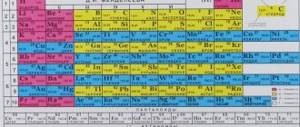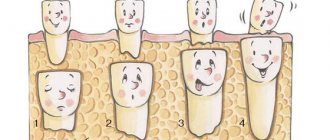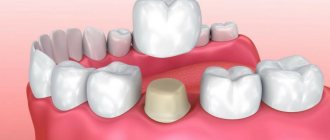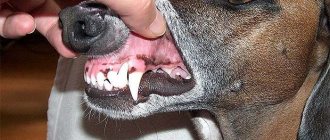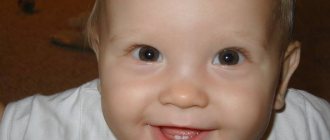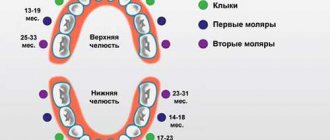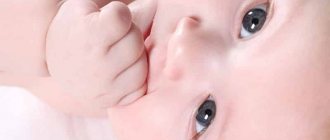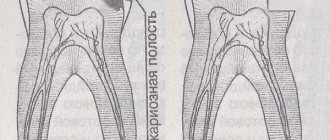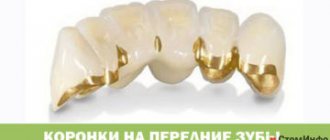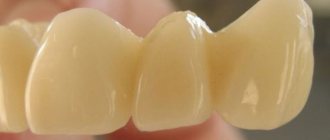Basic systems
Today there are several main numbering systems.
- Square-digital Zsigmondy-Palmer system.
- Haderup system.
- International two-digit Viola system.
- Universal numerical letter system.
Each of them is convenient in its own way and has its own characteristics for calculating permanent and baby teeth.
Square-digital Zsigmondy-Palmer system
The Zsigmondy-Palmer system, or the square-numeric system as it is also called, was adopted in 1876 and is still used to designate teeth in children and adults.
To count permanent teeth, Arabic numerals from 1 to 8 are used, and for milk teeth, Roman numerals from I to V are used. The calculation itself begins from the middle of the jaw.
Photo: Formula for recording permanent teeth according to the Zsigmondy-Palmer system
Photo: Formula for recording baby teeth using the Zsigmondy-Palmer system
The standard square-digit Zsigmondy-Palmer system is most often used by orthodontists and oral surgeons.
Haderup system
The Haderup system is distinguished by the use of "+" and "-" signs to indicate the upper and lower row of teeth, respectively. And the calculation of teeth according to the system is carried out by combining Arabic numbers with these signs.
Photo: Formula for recording permanent teeth according to the Haderup system
Milk teeth are designated in Arabic numerals from 1 to 5 with the addition of the sign “0” and, by analogy with permanent teeth, the signs “+” and “-”.
Photo: Formula for recording baby teeth using the Haderup system
International two-digit Viola system
The two-digit Viola system, adopted by the International Dental Association in 1971, has become widespread in dental practice.
The essence of this system is to divide the patient’s upper and lower jaws into four segments (two for each jaw) of 8 teeth. Moreover, for adults the numbering of segments is calculated from 1 to 4, and for children - from 5 to 8.
Photo: Formula for recording permanent teeth using the Viola system
Photo: Formula for recording baby teeth using the Viola system
If it is necessary to name a particular tooth, it is designated by a two-digit number, where the first digit is the number of the segment in which it is located, and the second indicates its serial number.
What is the reason for the widespread use of the international two-digit Viola system? First of all, with the absence of letters and complex formulas, which contributes to the ease of use and allows you to quickly and accurately transmit patient information by phone, fax, e-mail, etc.
Video on the topic
About the timing of the eruption of baby teeth and the formation of a permanent bite:
Thus, the dental formula of primary dental elements shows how many molars, canines and incisors a baby should have at a certain age. It is simple to interpret. Parents are advised to know the formula and compare the actual number of teeth in the child with the norm.
Dentists advise checking every 5-6 months from the moment teeth erupt. The formula allows you to identify violations at the initial stage and correct them in time: in children, dental problems are solved easier and faster than in adults.
Dental formula in children - what is it and what is it for?
› Children's
Loving parents always closely monitor the health of their children. But mothers and fathers experience special joy when the baby’s first teeth appear. Adults should know that in dental practice there is a dental formula for children.
This is a specific numbering of jaw units. Knowing the formula gives parents an understanding of how many milk crowns a child should have at a certain age. But don’t be upset if you notice small deviations in the deadline, they are acceptable.
Why is tooth numbering used in dentistry?
Numbering is used by dentists to simplify entries in a medical record, and in such a way that any other dentist can easily understand it. When checking a small patient’s teeth, the doctor records their condition using an alphanumeric code.
What is it for? The fact is that the configuration of the right and left parts of the dental jaw (both upper and lower) is completely identical and symmetrical.
Each crown has its own structure and performs its intended function. So a person bites off food with one teeth, and chews it with the other. All these features were taken into account when developing the coding system.
In practice, several types of schemes are used, which can consist only of a letter designation or be alphanumeric. Such a record is convenient and understandable for any dentist for further treatment and control of crowns, no matter which dental clinic the little patient goes to.
To understand the principle of tooth numbering, you need to understand what types of crowns exist in children and where they are located.
There are 4 types of baby teeth:
- incisors _ They are needed for biting food. 4 pieces on the upper and lower arc. There are 8 crowns in total: 4 central and 4 lateral;
- fangs . They are convenient for chewing hard food. A child, like an adult, has 4 of them: 2 on each jaw;
- first molars . They are needed for chewing food. There are 4 of them in total;
- second molars . Located behind the first ones. There are also 4 of them.
Thus, a baby should normally have 20 teeth. The anatomical structure of the jaw and the number of crowns in a baby differs from that of an adult.
If all permanent teeth are numbered from 11 to 48, then the following scheme is adopted for children’s occlusion:
- fiftieth teeth: upper right;
- sixties: upper left;
- seventies: bottom left;
- eighties: bottom right.
This numbering in tens from 5 to 8 is adopted because when the baby has all his milk teeth, the rudiments of permanent teeth have already formed under them.
This encoding is very popular among dentists and is called the Viola system.
In addition to this, there are other numbering schemes. Parents will benefit from knowing the dental formula for their children. It is simple: N = n – 4, where: n is the child’s age (expressed in months), and N is the number of baby teeth that have erupted. For example, if a baby is 10 months old, he should have 6 teeth: 6 = 10 – 4.
No matter how the teeth are numbered, there is a general rule: the initial count starts from the middle of the dentition, that is, between the first two incisors. They were assigned No. 1. Next, counting is done to the right and left of the first tooth. Each subsequent crown becomes No. 2, No. 3, and so on.
Universal dental formula for children of different ages
The universal formula differs from others in its alphanumeric description of all types of teeth:
- M – this letter denotes molars;
- P is the coding for premolars;
- C is the letter designation of the fangs;
- I – this letter marks the incisors.
For an adult, the universal formula is as follows (for the top row): IPM 16. That is, an adult has four incisors, two canines, six molars and four premolars on both jaws. Total: 16x2 = 32
If you look at the formula for children, you will notice the difference in the number of molars and the complete absence of premolars: ic 10. Total: 10x2 = 20
Baby teething begins at 6 months, but can be earlier. The first to appear, as a rule, are the 2 central teeth on the lower jaw arch. Then, symmetrically with them, the 2 front incisors erupt from above. Between 8 and 14 months, the baby's side teeth will come out.
At the beginning, 2 top ones will appear, followed by 2 bottom ones. From one year to 16 months, the first molars from the permanent row will erupt. Fangs will be formed by 18-20 months, and all 20 baby teeth will be formed by 3 years.
But if by the age of three the child does not have a complete set, do not be upset, there are reasons for this:
- genetics. If the parents erupted teeth late, the same will happen to the child;
- weakened immune system;
- lifestyle and nutrition of women during gestation;
- poor ecology in the place of residence.
You should be concerned if the baby has less than 10 teeth by the age of 3.
So, if we divide each row of teeth into two symmetrical segments, we get:
- М3М 2М 1 Р2 Р1 С I2 I1 | I1 I2 C P1 P2 M1 M 2M3 (top row);
- М3М 2М 1 Р2 Р1 С I2 I1 | I1 I2 C P1 P2 M1 M 2M3 (bottom row).
For any of the 4 segments, three “M”, two “I”, two “P” and one “C” are used. A number is added to each letter. For example, a lateral incisor is designated as I2 and so on.
The formula for a child is different (an example is given for a 10-year-old):
- m 2 M 1 P1 s I2 I1 | I1 I2 c P1 M1 m2 (top row);
- m 2 M 1 P1 c I2 I1 | I1 I2 c P1 M1 m 2 (bottom row).
From the formula it can be seen that the baby has replaced almost all temporary teeth (they are indicated in capital letters) with permanent ones (capital letters), and premolars have appeared.
Let's look at examples of dental formulas for children of different ages. When writing, we will use letters of the Latin alphabet and Roman numerals:
- one year old: BA | AB. All incisors have erupted;
- from one year to 1.5 years: D BA | AB D. We see that the first premolars have appeared (D). Pay attention to the gap where the fangs will appear in the future;
- from 18 to 20 months: DCBA | ABCD. During this period, the fangs (C) erupt;
- by the age of 2, posterior premolars (deciduous) are added: EDCBA | ABCDE. Now the baby has all 20 teeth formed. Next comes the process of cutting through permanent crowns and replacing baby teeth with them;
- at 5-7 years old, the first molars appear (indicated by the number 6): 6EDСBA | ABCDE6;
- at the ages of 7 to 9 years, the incisors change (indicated by numbers 1 and 2): 6EDС21 | 12CDE6;
- At the age of 12, the process of replacing temporary teeth with permanent ones is very active: canines, anterior and posterior premolars are replaced, then second molars grow. By this time, the child should already have 28 teeth. A permissible deviation of one year is normal. But wisdom teeth (or 3rd molars) form in everyone at different times, most often at 25 years of age. But they may appear later or not appear at all.
Children's dental formula according to the Haderup system
This system only uses numeric encoding. Its difference from others is that to distinguish the segments of the upper and lower jaw, plus and minus signs are used, respectively.
And to understand which tooth we are talking about, an Arabic numeral is assigned to “+” or “-”. So for the left segment (lower and upper), the number is placed to the left of the sign, and for the right - to the right.
The scheme for permanent crowns according to the Haderup system looks like this:
- 8+ 7+ 6+ 5+ 4+ 3+ 2+ 1+ | +1 +2 +3 +4 +5 +6 +7 +8 (top row;
- 8- 7- 6- 5- 4- 3- 2- 1- | -1 -2 -3 -4 -5 -6 -7 -8 (bottom row).
It is clear that the “4+” entry shows that the tooth is localized in the left segment of the upper row. But if the sign is in front of the number, for example, “+ 2”, then on the right.
In the case of baby teeth, the number series is shorter: from 1 to 5, and a zero is simply added to the main number (always on the left), for example:
- 05+0 4+0 3+0 2+ 01+ | +01 +02 +03 +04 +05 (top row).
- 05- 04- 0 3- 02- 01- | -01 -02 -03 -04 -05 (bottom row).
Zsigmondy-Palmer system and its decoding
This technique has found the widest application and is very popular in dental practice. It was developed back in 1876. The system is also called square-digital, since it was the first to use the division of all teeth into quadrants. There are only 4 of them.
To number permanent crowns, Arabic numerals from 1 to 8 are used, and for children’s crowns, Roman numerals are used from I to V. The counting also comes from the central teeth. To indicate the location of any crown, an icon resembling an angle is used: “G”, turned in different directions.
The numbering of the milk bite looks like this:
- at the central incisor – I;
- for the lateral incisor – II;
- canine designation – III;
- for the 1st premolar – IV;
- at the 2nd premolar – V.
For primary teeth, the encoding according to the Zsigmondy-Palmer scheme is as follows:
- V IV III II I | I II III IV V top row;
- 5th quadrant 6th quadrant (right segment) (left segment);
- V IV III II I | I II III IV V bottom row;
- 7th quadrant 8th quadrant.
For example, the entry "GIII" would indicate the location of the canine on the left side of the bottom row.
on this topic
Formula for the appearance of baby teeth in children:
Now you understand how dentists count teeth. Therefore, after reading the entry in the baby’s medical record, you will independently figure out what kind of crown we are talking about. And don’t be upset if your baby’s teeth don’t erupt exactly as expected according to the formula. Minor deviations are quite acceptable, because each organism is unique in its own way.
For some children, their first teeth will appear by the age of 4 months, while for others - after 7 months of age. But if you think the abnormalities are serious enough to cause you concern, consult a dentist.
Dental formula in children
Dentists use specific numbering when diagnosing and maintaining a patient’s history. The order of the jaw units and their condition is determined by the “dental formula”. There are several varieties of such formulas that doctors use for certain dental diseases.
Designations can be alphabetic, numeric (Roman, Arabic). The formulas are named after the inventors. The pediatric dentist is free to use in practice the standard numbering of Zsigmondy-Palmer and the international Viola, and the multifunctional alphanumeric and Haderup system.
Replacing baby teeth with permanent teeth
At about six and a half years of age, primary molars begin to fall out to be replaced by permanent molars. The middle incisors are the first to be replaced, then at 7–8 years old this happens with the lateral teeth, with large molars at 9–12 years old. In total, it may take about five years to completely replace primary teeth, but this is an average.
Proper nutrition
What your child eats during the teething period is important. Therefore, add dairy products (a source of calcium), as well as liver, sour cream, fish, eggs, and butter to his diet for better absorption. Don't forget seafood and cheese, which are high in phosphorus, and fruits and vegetables will provide enough vitamins. And, of course, limit your consumption of everything that contains sugar - cakes, sweets, sweet soda.
Proper care of baby teeth
The health of the temporary units determines how smooth and beautiful the permanent ones will grow. So be sure to visit your pediatric dentist and practice good oral hygiene at home. There are a number of principles by which you should achieve this:
- Starting from the very first molars, use a special finger attachment for cleaning; you can also take a piece of regular gauze;
- When your baby starts brushing his teeth on his own, watch how he does it - the procedure must be carried out twice a day;
- Gradually teach your child to use a rinse aid after cleaning; at first it can be a solution of baking soda or decoctions of medicinal plants;
- Do not delay the treatment of caries or removal of tartar, so as not to further provoke inflammation of the gums.
Dental formula in children: patterns and types of teeth arrangement
Dentists use specific numbering when diagnosing and maintaining a patient’s history. The order of the jaw units and their condition is determined by the “dental formula”. There are several varieties of such formulas that doctors use for certain dental diseases.
Designations can be alphabetic, numeric (Roman, Arabic). The formulas are named after the inventors. The pediatric dentist is free to use in practice the standard numbering of Zsigmondy-Palmer and the international Viola, and the multifunctional alphanumeric and Haderup system.
What is numbering used for?
Numbering is used by dentists to optimize diagnostic procedures in the oral cavity of a small patient and subsequently enter the obtained data into an outpatient card. Why is numbering so necessary according to certain criteria, how are jaw units numbered? The structure of the dental system is taken into account. Each of its units has a specific configuration taking into account the assigned tasks.
With one teeth a person bites off pieces of food, with the other he crushes them to a state convenient for swallowing. In order to accurately identify problem teeth for the purpose of further control and treatment in this and other clinics, crown numbering was invented. It starts from the central part of the row and diverges on both sides.
To give parents an approximate idea of how many milk units of the jaw children should have by a certain age, there is a simple formula: N = n, 4. The letter N indicates the number of milk (temporary) crowns in a child, and n is the baby’s age (months are taken into account). Based on the result of a simple calculation, parents can notice deviations in time, but this is not a reason to panic.
Each organism develops individually, small deviations are a variant of the norm.
How formulas are deciphered
The alphabetic or numerical designation of teeth in children differs from the methods intended for adults, since the anatomical features of the jaw in small patients vary, as well as the number of crowns.
The process of eruption of temporary crowns begins around 4-6 months. By this period, the formation of the rudiments of the radical units of the jaw takes place in parallel.
If a child is x-rayed by the age of 5, you will notice both primary and permanent crowns.
All primary crowns are numbered from 11 to 48, and milk crowns are numbered in the following tens. This means that the fiftieth teeth will be located on the right side at the top, the sixties on the left side at the top, the seventies at the bottom left of the center, and the eighties on the right.
Therefore, you should not be surprised if the pediatric dentist told the parents that there is a problem with the 72nd tooth and treatment is necessary. This means the number of teeth in the mouth, but only the serial number according to the accepted numbering system.
When it comes to deciphering a dental formula, you first need to clarify which system is being talked about. There are several options that doctors use in practice, and each is characterized by advantages, disadvantages, and features of calculating jaw units (mammary, permanent):
- Haderup system. The peculiarity of the numbering comes down to the presence of mathematical signs “+” and “-”, indicating the molar crowns on the upper and lower sides, respectively. For the calculation, one of the indicated signs is used along with Arabic numbers. According to this system, dairy products will be designated by Arabic numerals (1-5), adding “0” and one of the characters indicated above,
- Zsigmondy-Palmer calculus, square-digital. Began to be used in 1876, relevant today. Arabic numerals (1-8) are successfully used to designate all molars; milk teeth are designated by Roman numerals (IV). The count starts from the central part of the jaw. Typically, this numbering is used by orthodontists, as well as surgeons performing operations on the jaw,
- Viola system, so-called two-digit. This numbering has been adopted by doctors of the International Association of Dental Practitioners since 1971. The system is quite widespread and is actively used today. The counting process begins by imagining the jaws being divided into 4 segments (2 below, 2 above). Each segment covers 8 molar crowns. For adult patients, the segments are numbered from 1 to 4; for children, numbers from 5 to 8 are chosen. To document a specific crown, a 2-digit number is displayed, where 1 number indicates a specific segment in the mouth, and 2 indicates the tooth number. The number method has become popular due to the elimination of complex formulas and letters, ease of use, and the speed of transferring patient information on paper, by fax, by telephone, or e-mail.
What is the universal formula
The American Association of Dental Practitioners has approved a universal system of alphabetic as well as numeric symbols. Its main difference lies in the letter designation of each crown - canine, incisor, molar. Numbers are used to clarify the position of a tooth in a row, taking into account the accepted sequence.
The letter I describes the incisor. There are 8 of them in the permanent bite, two for each segment. Doctors use the letter C to describe fangs. At the distance of each segment there is one of them, a total of 4. Premolars are described by the letter P. There are 8 of them. Molars are described by the letter M, and when it comes to permanent dentition with erupted wisdom teeth, there are a total of 12 of them in the mouth.
https://www.youtube.com/watch?v=ZFOe_k04ML0
The universal formula allows for the numbering of jaw units by segments, when teeth performing the same function are designated by the same serial number.
According to this numbering method, by analogy with the Viola system mentioned above, the number of the segment where the tooth grows is described, the result is a two-digit number.
When we are talking not about permanent, but about baby teeth in children, in addition to the letter designation, they can be numbered from the top right, moving clockwise, in a circle.
In this case, letters of the Latin alphabet will be used, starting from A to K.
What to do when the teething order is disrupted
Delayed eruption and confusion in the order in which primary teeth appear are not uncommon. The reason can be heredity (if one of your ancestors had teeth coming out late), as well as other factors.
Most cases are associated with genetic predisposition. When parents or grandparents had a delayed appearance of teeth in childhood, but did not experience any problems, then the delay in the appearance of teeth in a child should not cause panic.
Typically, children catch up with their peers in terms of development in the near future.
There are situations when the late appearance of teeth indicates the presence of any abnormalities in the body. For example, premature babies or those children who were born with insufficient body weight usually have defects in the enamel of primary teeth; they appear later than the average values that are calculated by the formula.
Diseases in which a child’s teeth are poorly formed, developed, or appear late are genetic in nature. This may be focal odontodysplasia or amelogenesis imperfecta. It is not possible to independently determine such a disease in a child, so a consultation with a pediatric dentist is necessary.
Another reason for disrupted teething is poor nutrition, when the child’s diet does not have enough minerals, vitamin D, calcium, and other beneficial microelements.
Down syndrome and underactive thyroid gland (hypothyroidism) are other options for conditions in which teeth will appear later than the standard time frame.
Hypothyroidism is accompanied by other symptoms - fatigue, weakness, difficulty moving joints, and headaches.
In a child, hypothyroidism manifests itself as delayed speech skills, problems with walking, and the appearance of excess weight.
The conditions listed above are not a reason to sound the alarm. In most cases, late eruption does not threaten anything serious, however, you need to see an orthodontist or dentist to rule out pathologies.
If the child cannot be given solid food, it is necessary to enrich the diet with soft foods containing a complex of useful substances.
If the jaws are empty when the child is 1.5 years old, you must inform the doctor in order to identify the cause and take action.
A normal deviation from the standard schedule is +/- 6 months. Incorrect sequence does not require intervention or correction at all. The body simply develops the way it needs. There are no cures for disrupted teething, so you should not stuff your baby with chemicals.
Do you feel nervous before visiting the dentist?YesNo
Advantages and Disadvantages of the Formula
The listed numbering systems and dental formulas in dentistry have certain advantages and disadvantages. For example, the universal formula is considered inconvenient for indicating the right and left parts of the jaw, so errors often occur in the description of dental problems, which can lead to incorrect treatment.
A similar misunderstanding arises when applying the Handerup system. As for the Zsigmondy-Palmer system, it is chosen by surgeons and orthodontists who perform jaw surgery. Regular dentists consider the Viola system to be the best of all options.
It makes it possible to quickly and easily identify problem areas, begin treatment, and monitor the treated jaw units in the future without confusion.
Source: https://za-rozhdenie.ru/stomatologiya/zubnaya-formula-u-detej
Dental formula of an adult and milk units in children: diagrams with interpretation and description
Teeth are bone formations in the oral cavity, which are the main part of the dentofacial complex. They perform such important functions in our lives as biting and chopping food, producing sounds and many others. The dental system and its good condition are the main component of quality of life.
Types, functions and number of teeth in adults and children
During normal development, a person erupts 20 temporary and 28-32 permanent teeth. The range of their number varies depending on the hereditary predisposition - whether the rudiments of the third molars, called “eights” or wisdom teeth, have formed.
The units are sequentially located in the jaws and form rows - upper and lower. Each contains 16 teeth: 4 incisors, 2 canines, 4 premolars and 6 molars. In children, the arch consists of 10 units on each jaw.
Why do you need a dental formula?
The location of the dental units and their number are recorded by the doctor in the form of a table, which fully reflects their condition. The formula allows you to simplify the task of correct diagnosis of diseases in the oral cavity (caries, pulpitis, etc.) and the most specific recording of information in the patient’s outpatient record.
When visiting a dentist, especially with acute pain, the patient can rarely accurately indicate the causative factor. By looking at the chart and assessing the dental formula, the doctor will understand what he will be working with.
Formulas used
The structure of the dental system record has some features:
- the arrangement of teeth in the arch is strictly sequential;
- the row is divided into two symmetrical parts;
- the formula is compiled in such a way that the units of each half of the jaws are written in it;
- numbering is carried out using letters and numbers;
- the dental formula is read from the doctor’s perspective (from left to right, clockwise, where your right side will correspond to the upper left segment).
Universal Dentistry Formula
The entry in the universal formula is based on dividing teeth according to group affiliation and assigning them a letter equivalent:
- incisors – I;
- fangs – C;
- premolars – P;
- molars – M.
Graphic representation of the table for an adult:
| M3 | M2 | M1 | P2 | P1 | C | I2 | I1 | I1 | I2 | C | P1 | P2 | M1 | M2 | M3 |
| M3 | M2 | M1 | P2 | P1 | C | I2 | I1 | I1 | I2 | C | P1 | P2 | M1 | M2 | M3 |
For a child:
A simplified universal formula has been developed. Based on this calculation, each unit is assigned a serial number from 1 to 32 in a clockwise direction, starting with the upper right third molar (1) and ending with the lower "eight" of the same half (32):
| 1 | 2 | 3 | 4 | 5 | 6 | 7 | 8 | 9 | 10 | 11 | 12 | 13 | 14 | 15 | 16 |
| 32 | 31 | 30 | 29 | 28 | 27 | 26 | 25 | 24 | 23 | 22 | 21 | 20 | 19 | 18 | 17 |
Zsigmondy-Palmer system
This method was created in 1876 and is used in modern dentistry. Its other name is square-digital. The structure of the record is based on the numbering of dental units from 1 to 8, depending on their group affiliation and arrangement order, where:
- 1 – central incisor;
- 2 – lateral;
- 3 – fang;
- 4 – first premolar;
- 5 – second;
- 6 – first molar;
- 7 – second;
- 8 – third.
The rows of jaws are divided in half. The result is a square consisting of four segments. The countdown goes from the center to the left and right:
| 8 | 7 | 6 | 5 | 4 | 3 | 2 | 1 | 1 | 2 | 3 | 4 | 5 | 6 | 7 | 8 |
| 8 | 7 | 6 | 5 | 4 | 3 | 2 | 1 | 1 | 2 | 3 | 4 | 5 | 6 | 7 | 8 |
Children's teeth are indicated in Roman numerals, in segments from the center:
- central incisor – I;
- lateral – II;
- canine – III;
- first primary molar – IV;
- the second is V.
Type of this formula for children:
| V | IV | III | II | I | I | II | III | IV | V |
| V | IV | III | II | I | I | II | III | IV | V |
Two-digit Viola system
This technique was adopted in 1971 by the International Dental Association. Currently it is the most popular in use by doctors. The essence of the two-digit calculation is to assign a two-digit number to the tooth. In this case, the rows are divided in half, forming segments. There are four in total:
- top right side;
- top left;
- lower left;
- lower right.
To determine the position of a molar in the oral cavity, it is assigned the value of the corresponding segment. An Arabic numeral indicating the location is placed in front of its number.
The WHO numbering order of teeth corresponds to the group affiliation and their location (the numbering was given in the previous section). Below is a graphical representation of the calculation of the adult formula using this system:
READ ALSO: In what order are teeth located in the mouth?
| 18 | 17 | 16 | 15 | 14 | 13 | 12 | 11 | 21 | 22 | 23 | 24 | 25 | 26 | 27 | 28 |
| 48 | 47 | 46 | 45 | 44 | 43 | 42 | 41 | 31 | 32 | 33 | 34 | 35 | 36 | 37 | 38 |
When filling out a patient's outpatient chart, the doctor will begin to assign a double value to each tooth. The signs will be located through a dot. For example, the lower left first premolar will acquire code 3.4, where the number 3 indicates the segment and 4 the account number.
The method is also used in children's practice. Decoding of quadrants is based on values from 5 to 8:
- top right side – 5;
- top left – 6;
- lower left – 7;
- lower right – 8.
When designating milk units, Arabic numerals are used:
- central incisor – 1;
- lateral – 2;
- fang – 3;
- first molar – 4;
- second – 5.
Below is the dental formula for recording this system for children:
| 55 | 54 | 53 | 52 | 51 | 61 | 62 | 63 | 64 | 65 |
| 85 | 84 | 83 | 82 | 81 | 71 | 72 | 73 | 74 | 75 |
Haderup system
The technique is based on the Zsigmondy-Palmer method. The teeth of the same name in the upper and lower jaws are designated by the same Arabic numerals from 1 to 8. As in the two-digit Vilor system, a symbol is assigned to indicate the quadrant in which the tooth is located.
An example of a formula for recording a person using this method:
| 8+ | 7+ | 6+ | 5+ | 4+ | 3+ | 2+ | 1+ | +1 | +2 | +3 | +4 | +5 | +6 | +7 | +8 |
| 8- | 7- | 6- | 5- | 4- | 3- | 2- | 1- | -1 | -2 | -3 | -4 | -5 | -6 | -7 | -8 |
In children, Arabic numbers from 1 to 5 are used in the temporary dentition, with a 0 added before the number. It is this that indicates that the tooth is a milk tooth. The "+" and "-" symbols are used in a similar way:
| 05+ | 04+ | 03+ | 02+ | 01+ | +01 | +02 | +03 | +04 | +05 |
| 05- | 04- | 03- | 02- | 01- | -01 | -02 | -03 | -04 | -05 |
What formulas are used in pediatric dentistry?
The eruption of baby teeth has a strict sequence and specific timing. Each time period corresponds to a certain number of units.
Parents often worry whether their children are okay? How many baby teeth should they have at a certain age? Starting from the eruption of the first temporary units, it is necessary to check their number with the dental formula corresponding to the given period.
READ ALSO: How many teeth should an adult have?
In pediatric practice, dentists resort to various schemes for designating primary occlusion. The doctor works with the one who, in his opinion, fully meets his requirements.
Source: https://MikDent.ru/stomatolog/o-zubax/zubnaya-formula-v-stomatologii.html
